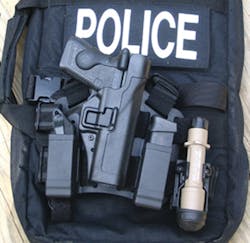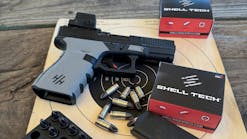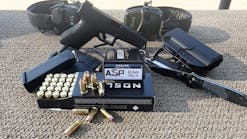Build Your Holster Platform
Just a couple weeks ago I was teaching a handgun course and there came a point on the range where I realized, looking down the line of students, that every one of them was wearing / carrying their handgun differently. There is absolutely nothing wrong with that, but the follow on was me examining each platform trying to ascertain what specific purpose it had been built for. Obviously it had to carry the handgun securely but one guy had two magazine pouches also mounted; another had a flashlight and a knife; another yet had a grenade pouch on his... things that make you go "hmmm..." So, with those thoughts in mind, I felt it would be good to discuss a few options and offer up a few suggestions for what they're worth.
Understand up front that I'm only talking about "tactical" platforms. Of course, they were deemed "tactical" because, back in the day, they were most often used by SWAT folks. Since then we've (shooters) come to realize that all of the characteristics that make them great for use by SWAT guys and soldiers also makes them great for use by we "commoners". (I'm not a SWAT guy anymore) What makes them so great?
First off, they position the handgun down off your hip. For uniform use that may not be optimal (and your agency may not allow it), but when you think about drawing your sidearm, it's far easier to get it up and out of a holster that's on your thigh as compared to the holster that's up on your hip. Further, depending on whether you use a low-ride, mid-ride or high-ride mount for your hip-level duty holster, you may have to almost stick your elbow in your ear to get your gun out. Also, if you've ever tried to draw your handgun while seated in a vehicle (from that hip-level holster) you've realized it's not as easy as the movies make it seem. With the weapon down in a thigh-mounted holster you can move it around a little on your leg so that it's actually closer to the top of your thigh as you're seated - usually making it easier to get to.
Secondly, by moving the holster down onto the platform, you free up some landscape on your duty / gun belt. Depending on how much gear you're trying to put on that belt, having an extra two to four inches might make all the difference in the world.
Finally, since the platform that the holster mounts on is wider than the holster itself and (typically) at least as tall as the holster is with the weapon included, you have some space onto which you can mount other items. That is, of course, assuming that the manufacturer of the platform you're using thought of that and gave you any space to work with - or a method for doing so. What you use that space for (and how) is the topic of this article.
Now, many a manufacturer makes a "tactical platform". Quite a few of the traditional holster makers in the law enforcement market altered a duty holster by putting it on a thigh platform so that they could add a "tactical holster" to their product line. The manufacturers who actually gave it more thought than increased sales saw the opportunity to ALSO sell some accessories IF they provided space and a means to mount those accessories to the newly available platform space.
The first attempt by some companies was to provide thigh straps that were of sufficient size and stiffness to carry pouches normally worn on a gun belt. While that worked (and still does), it tends to make the thigh straps a tad uncomfortable unless they're well broken in - and then they tend to bend and warp so that the pouches aren't necessarily all held where and how you place them.
The second attempt (also still in use by some) was to mount pouches to the holster body itself. This worked (and still does) pretty well with nylon holsters and the utility pocket usually fits a spare magazine as well as some flashlights or knives.
With a closer look at nylon platforms, and with the advent of the MOLLE system, some manufacturers got smart and started putting MOLLE webbing on the platforms and a few even went so far as to make the holster body itself modular so that the MOLLE "tactical thigh" platform could be completely customized to your handgun and whatever you wanted to put on it. The challenge was hanging that MOLLE covered nylon platform off a single stiff strap that hung off your gun belt at your hip. Still, this is a good platform to work with - and with a piece of soft body armor inside the nylon platform, it even offers some extra protection from projectiles.
The best I've seen (just my opinion and preference) comes from BLACKHAWK. After they produced their SERPA holsters and then the thigh platform for carrying such, the next step was immediately taken to create a blank platform that is MOLLE/STRIKE (BLACKHAWK's proprietary MOLLE compatible system) compatible. Taking that concept one step further, they offered a secure method for putting a mounted rail system on the platform that allowed users to build said platform into almost any variation they could want. The interoperability of the CQC magazine pouches, flashlight holsters, knives sheaths, etc allow you to build the platform as you need it quite securely and with a minimum level of work - once you know what you want. And, as a guy who just can't resist doing something different, I've also used zip-ties to mount other manufacturer's products to the BLACKHAWK platform.
So, before you build your platform you need to know a few things:
- What handgun are you building it around?
- What accessories do you want to add on the platform?
The handgun is totally your preference unless it's an assigned duty weapon. I've built platforms around 1911s, Beretta M9s (92/96FS), Glocks and Sig Sauer P226s. Let me share two examples so you can get an idea of what's easily possible.
Springfield Armory 1911 platform
I started out with a Level III SERPA Duty Holster from BLACKHAWK for a government model 1911 type pistol. As I already had plenty of extra magazines on my gun belt and vest (which I'd almost always be wearing if I had on this holster), I wanted to add a decent flashlight and a knife. In particular, I wanted to add a knife I could use both to cut and penetrate as well as to pry. With the platform and holster picked out I chose the Night-Ops Gladius flashlight with a Mod-U-Lok holder for it (also from BLACKHAWK). The knife I chose was a Cold Steel Recon Tanto. It's thick blade made it a good pry tool and the tanto style blade gave it good penetrating ability. I decided I'd more often need the light than the knife so I placed the light in front of the holster where it was more easily reached by either hand. I placed the knife sheath behind the holster and had to zip-tie it on because the Cold Steel sheath didn't have attachment points to suit my needs. With the platform placement adjusted correctly, when I relax my right arm / hand, the pistol's grip is just a short distance above (I wear my tactical thigh platform a bit higher than most), the light is right there and the knife is just a short reach back.
Glock Model 17 platform
I built this platform predominantly for my wife. Her primary sidearm (should she need one) is a Fourth Generation Glock Model 17 9mm. I have seven magazines for that pistol. With one in the gun, two on her gun belt and two on her equipment vest, I have two left that need to go somewhere. However, knowing I was going to put a magazine pouch on the platform, I had to decide what else was going on it and what would be place in front and back. With four magazines elsewhere within easy reach, I felt that the magazine on the holster didn't have to be in front. I put it behind the holster and it sits within easy reach just below the gun's grip. It's ideally placed if, for some reason, she's shooting with her left hand (her non-dominant hand) and has to reload with her right. In front of the holster I put a BLACKHAWK Razorback TROCAR knife. It's only got about a 4" blade but is wicked sharp and the spine has notches preplaced for using the knife in medical applications. The TROCAR is much lighter than my Cold Steel Recon Tanto so her holster platform as a whole is also lighter. Since I didn't perceive the same level of security needed for her holster, I used a Level II SERPA Duty Holster which provides plenty of coverage and two methods of security.
That's just two examples of how easy it is to build platforms to suit your need(s). After I finish with this article, I'm going to build a shotgun ammo platform for my left thigh. My preferred long gun is my Remington 870 shotgun and even with its extended magazine tube and two shell holders (one on the side of the receiver, one on the side of the stock) I only have 17 rounds in or on the gun. By using a blank tactical thigh platform on my left side (my non-dominant side) I can mount two shotshell pouches that hold 18 rounds each adding another 36 rounds of ammo carrying capacity. On my left side I can feed the rounds into the weapon's magazine tube with my left hand, just as I would if I were loading from my pocket or a vest.
The bottom line is that building a tactical thigh platform takes a bit of thought and planning, but can be easily customized to suit your needs - within the confines of the real estate available on the platform itself.
Stay safe.
Web Links:
About The Author:
Lt. Frank Borelli (ret) is the Editor In Chief for Officer.com, and has over 29 years of military and civilian law enforcement experience. An instructor since 1989 and having delivered training across the country, he stays active in police work, training, and writing. Frank has had four non-fiction and two fiction books published along with two research papers of specific interest to the law enforcement and/or military communities. All can be found / purchased on his Author Page on Amazon.com linked above. If you have any comments or questions, you can contact him via email to [email protected].

Lt. Frank Borelli (ret), Editorial Director | Editorial Director
Lt. Frank Borelli is the Editorial Director for the Officer Media Group. Frank brings 20+ years of writing and editing experience in addition to 40 years of law enforcement operations, administration and training experience to the team.
Frank has had numerous books published which are available on Amazon.com, BarnesAndNoble.com, and other major retail outlets.
If you have any comments or questions, you can contact him via email at [email protected].



